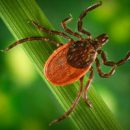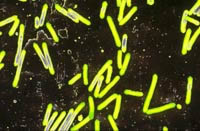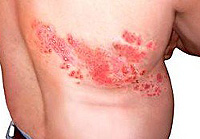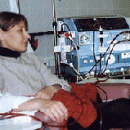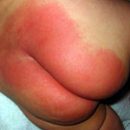Ebola hemorrhagic fever epidemic continues to firmly on the African continent, she moved to Europe, China, in the USA, which allows us to talk about it, as a threat of a global scale. What kind of disease is and what is his danger? About this in the article.
Content
About the hemorrhagic fever of Ebola Most of us learned in the spring of this year, when another outbreak of the disease began in West Africa. According to the World Health Organization today, the Ebola virus has lost more than 1060 people, 1800 more on the verge of life and death are. Ebola viral infection epidemics arose in former times, however, the current outbreak exceeded the number of victims, all preceding. The disease continues to firmly on the African continent, she moved to Europe, China, in the USA, and this allows us to talk about it as a threat of a global scale.
What is hemorrhagic ebol fever?
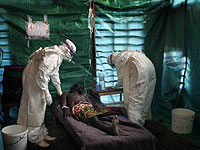 Hemorrhagic fever Ebola — Severe infectious disease of the viral nature caused by the agent of the same name. Despite the limited prevalence, infectiousness of infection and the characteristic mortality, reaching 90%, allow the ebola fever to the most dangerous diseases of our time.
Hemorrhagic fever Ebola — Severe infectious disease of the viral nature caused by the agent of the same name. Despite the limited prevalence, infectiousness of infection and the characteristic mortality, reaching 90%, allow the ebola fever to the most dangerous diseases of our time.
The Ebola virus was first highlighted in 1976 in Zaire (Congo) in the Ebola River area, this gave the name of the pathogen. Later, his species were discovered in other regions of Africa, in Sudan, in the cat’Ivoire, in Reston and Uganda, but the most dangerous is still the Zaire version.
The reservoir of infection is considered rodents, it is in their populations that the virus circulates constantly, periodically falling towards man. It is believed that in addition to a person with fever, primates may hurt and, as it turned out, even pigs.
A person's infection occurs when contacting a contaminated person or animal, and, as with the sick, and already already impropered. The virus is in biological fluids and patient tissues, starting with 3 days of the disease, and stands out to the environment with saliva, urine, feces, then, seed liquid. Cancel the deadly infection in contact with contaminated item, dishes, linen. Blood infected is especially dangerous, given that the fever is accompanied by bleeding, the highest risk of getting sick among those who treat and care for patients. According to some data, the Ebola Virus of the Zaire type can still be transmitted by air-droplet, however, this path of transmission is not the main.
Ebola fever symptoms
The incubation period of Ebola fever ranges from 2 to 20 days, an average of 8 days. During this time, the causative agent that penetrates the body through the skin and mucous membranes, reaches regional lymph nodes and multiplies to a critical mass capable of causeing disease. 8 days later from the moment of infection, breaking «Cordons» lymphatic system, the virus enters the blood and is distributed over all organs and tissues. This period is called virusemia, it coincides with the time with a sharp rise in body temperature above 39-40 0With, the appearance of weakness, headaches, lobs in muscles and joints, nausea, decline in appetite. Most patients have signs of follicular angina. The development of infection leads to the disseminated blood coagulation syndrome, small vessels, microcirculation impaired, tissue bleeding.
For 5-6 days, the whole body of a patient with a hemorrhagic fever is covered with finely plum red rash, which forms crimson stripes on the articular bends. The gums begin to bleed, nasal bleeding open, the blood appears even on the eye conjunctival. Bleeding from the digestive tract is accompanied by bloody vomiting, diarrhea, callers acquires typical black color. The development of anemia, immunity violations further exacerbate.
The death of cells of the internal organs leads to severe hepatitis, pancreatitis, pneumonia, jade, the development of polyorgan deficiency, which, along with infectious and toxic shock, becomes the cause of the patient's death.
Acute phase of the disease lasts 2-3 weeks. Doctors noticed if the patient does not die during this period, then he appears a chance for recovery.
Recovery after infection lasts 2-3 months, accompanied by pronounced weight loss, weakness, peeling of the skin, hair loss throughout the body and on the head, and sometimes even the development of mental disorders.
Is there a medicine from Ebola fever?
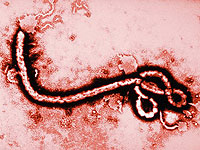 Specific drugs that would destroy the ebola virus are still not, exactly, like vaccines that would be used to prevent the disease.
Specific drugs that would destroy the ebola virus are still not, exactly, like vaccines that would be used to prevent the disease.
Work on the creation of vaccines and immune drugs that could protect the world from the fever epidemic are conducted, the results are encouraging, but do not allow to hope that the infection will be taken under control in the near future.
The treatment of Ebola fever today is purely symptomatic. It is aimed at compensating for losses of liquid with vomit masses and a liquid chair, elimination of dehydration by drinking fluid and intravenous injections of special solutions. To combat internal combustion — The syndrome uses plasma-substituting technologies and medication methods for regulation of the working blood coagulation system — they give sick some chance for recovery, but do not guarantee him.
WHO experts believe that the current Ebola fever epidemic is also gaining strength, we can only keep prevention measures and hope that the epidemic will not turn into a pandemic.


